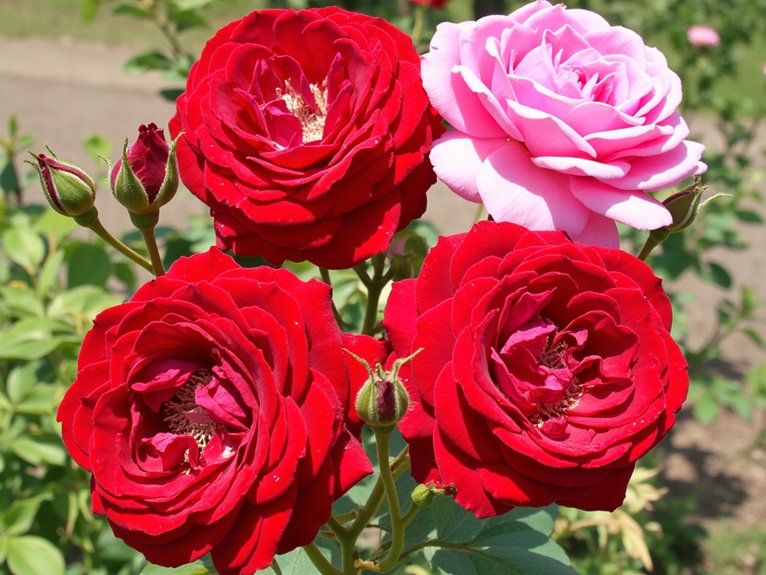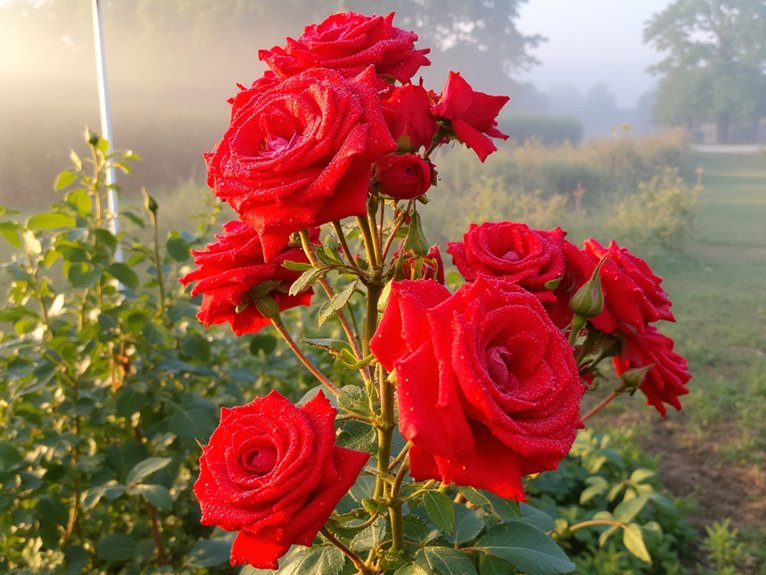The world of large-flowering roses opens up remarkable possibilities for garden design and visual impact. Master gardener Thomas Wilson notes, “Varieties like Medallion and Paul Neyron transform ordinary spaces into extraordinary displays with blooms reaching up to 8 inches across.” These magnificent specimens demand specific growing conditions and careful attention to thrive, from soil preparation to strategic pruning techniques. Gardens featuring these statement roses offer more than just size – they deliver an complete sensory experience that changes through the seasons.
Contents
- 1 Choosing the Perfect Large-Blooming Rose Varieties
- 2 Essential Growing Conditions for Magnificent Blooms
- 3 The Art of Nurturing Award-Winning Roses
- 4 Creating Visual Impact With Statement Roses
- 5 Climate’s Role in Growing Show-Stopping Roses
- 6 Mastering Disease Prevention for Healthy Blooms
- 7 Fragrance and Form: The Complete Package
Choosing the Perfect Large-Blooming Rose Varieties

When selecting large-blooming roses for a garden, gardeners should consider several key varieties that consistently produce impressive flowers throughout the growing season. Standout hybrid tea options include the Medallion rose, which produces stunning 7-8 inch apricot blooms, and Paul Neyron, featuring massive lilac-magenta flowers. For reliable performance, the Chicago Peace and Miss All-American Beauty varieties reach heights of 5-7 feet with spectacular blooms. These selections thrive in full sun conditions and adapt well to zones 7-11, making them excellent choices for creating dramatic focal points in both formal and informal garden settings.
Essential Growing Conditions for Magnificent Blooms
To achieve magnificent blooms, large-flowering roses require specific growing conditions that enhance their health and flowering potential. Proper soil preparation begins with testing pH levels, aiming for 6.0-6.5, and incorporating organic matter into well-draining soil. Water management plays an essential role, with deep weekly watering of 1-2 inches reaching the root zone.
For best results, roses need 6-8 hours of direct sunlight daily, proper air circulation between plants, and consistent fertilization throughout the growing season. “The secret to stunning blooms lies in maintaining proper moisture levels while avoiding wet foliage,” notes the American Rose Society.
The Art of Nurturing Award-Winning Roses

Several award-winning rose cultivars require meticulous attention to achieve their full potential for spectacular blooms and robust growth. Essential rose care practices include maintaining consistent moisture levels and fertilizing three times annually during key growth periods.
Proper pruning techniques focus on removing dead or crossing branches while shaping the plant to promote air circulation. Master rosarian Thomas Wilson notes, “The most successful rose gardens implement systematic care schedules, particularly with award-winners like ‘Medallion’ and ‘Paul Neyron,’ which need precise maintenance for their signature large blooms.”
These cultivars flourish best with 6-8 hours of direct sunlight and well-draining soil enhanced with organic matter.
Creating Visual Impact With Statement Roses
Dramatic garden displays start with strategic placement of statement roses that command attention through their impressive blooms and stature. Towering varieties like Chicago Peace and Miss All-American Beauty, reaching heights of 5-7 feet, create stunning focal points when positioned at garden corners or entry points.
For vibrant displays, combine roses of varying heights and complementary colors. Plant shorter varieties like Charles Darwin (3-4 feet) in front of taller specimens, ensuring each row receives adequate sunlight. Space plants 3-4 feet apart to promote air circulation and maintain healthy growth for maximum visual impact.
Climate’s Role in Growing Show-Stopping Roses

While climate plays a defining role in rose development, gardeners can achieve spectacular blooms by understanding their local growing conditions. The Pacific Northwest’s long, cool springs promote larger flowers, while shorter growing seasons in northern regions typically yield smaller blooms.
Success requires climate adaptation strategies tailored to regional patterns. Gardeners should monitor seasonal fluctuations and adjust care accordingly:
- Provide extra winter protection in zones 4-6
- Increase watering frequency during hot, dry spells
- Schedule fertilization based on local frost dates
- Choose varieties proven hardy for the region
- Position roses to maximize available sunlight hours
Mastering Disease Prevention for Healthy Blooms
Beyond optimizing for climate conditions, maintaining robust disease prevention practices determines the difference between mediocre and magnificent rose blooms. Success requires vigilant monitoring and early intervention to protect the plant’s health.
Experts recommend these essential steps for disease resistance:
- Prune away infected foliage promptly
- Space plants for adequate air circulation
- Water at soil level to keep leaves dry
- Apply fungicides preventively in humid conditions
- Monitor for common issues like black spot and powdery mildew
Proper pest management also plays an important role. Regular inspection and targeted treatments help maintain plant vigor, ensuring roses reach their full blooming potential.
Fragrance and Form: The Complete Package
The finest rose specimens combine stunning visual appeal with intoxicating fragrances that engage multiple senses in the garden. Varieties like John F. Kennedy showcase unique scent profiles featuring hints of licorice, while Medallion delights with citrus and anise notes. These fragrances pair perfectly with their distinctive bloom shapes.
Award-winning varieties demonstrate this harmony between form and fragrance. Paul Neyron’s massive lilac blooms complement its intense old rose perfume, while Oshun pairs 6-inch apricot flowers with an acclaimed citrus scent. In ideal conditions, these roses release their strongest fragrances during warm afternoons, creating an immersive garden experience.
